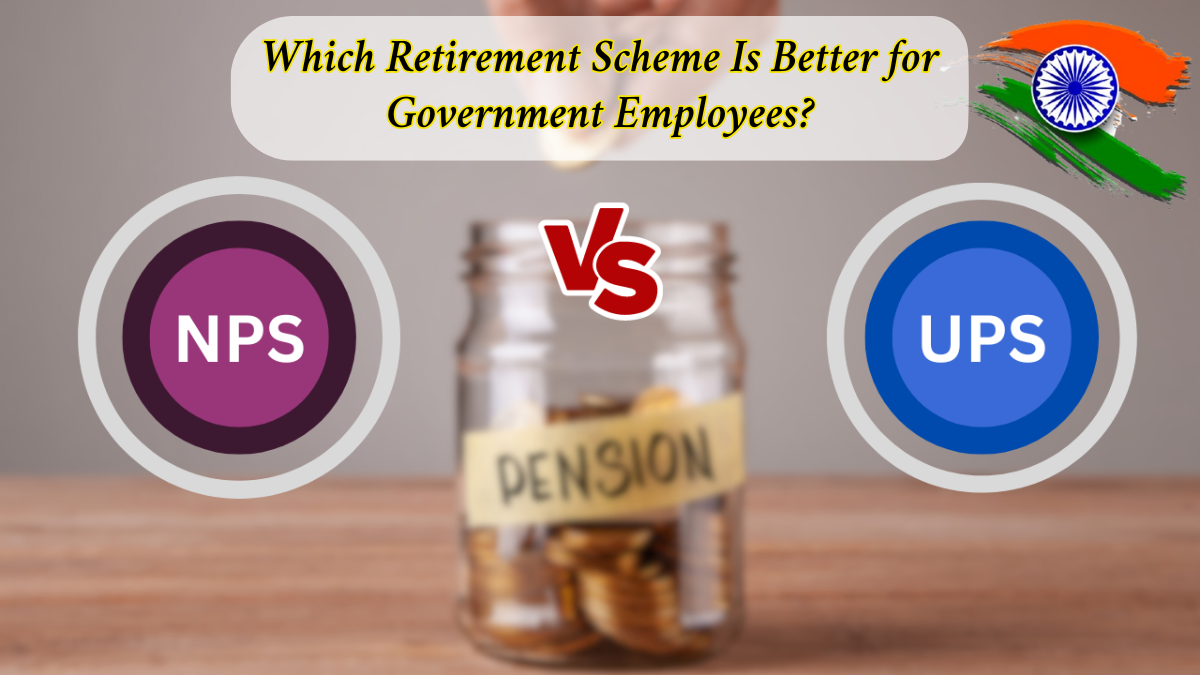Effective April 1, 2024, the Government of India introduced the Unified Pension Scheme (UPS) for central government employees, offering a fixed post-retirement income. This major shift in pension policy now allows central employees to choose between the National Pension System (NPS) and the new UPS, depending on their preferences and financial goals.

This decision is pivotal in retirement planning. While NPS offers market-linked growth and tax advantages, UPS provides the security of a fixed monthly pension. The big question now is: Which scheme is better?
In this guide, we compare NPS and UPS in detail—covering features, contributions, benefits, and risks—so you can make an informed decision.
Table of Contents
Summary: NPS vs UPS for Government Employees

Criteria |
NPS (National Pension System) |
UPS (Unified Pension Scheme) |
|---|---|---|
Pension Type |
Market-linked, variable return |
Fixed monthly pension (50% of average last 12 months’ basic pay) |
Contribution (Employee) |
10% of basic salary |
10% of basic salary |
Contribution (Government) |
14% of basic salary |
18.5% of basic salary |
Return Type |
Depends on market performance |
Guaranteed fixed income |
Minimum Service Requirement |
No minimum to exit, but lower benefits before 60 |
25 years of service required for full pension benefits |
Inflation Adjustment |
No automatic adjustment |
Yes, pension revised with inflation |
Tax Benefits |
Section 80C, 80CCD(1B), and 80CCD(2) deductions |
Limited to standard deductions |
Lump Sum Benefit |
60% lump sum withdrawal allowed at retirement |
Yes, based on last salary |
Flexibility & Portability |
Highly flexible, open to private sector and portable |
Restricted to central government employees |
Risk |
Market risk present |
Virtually risk-free |
Official Website |
Government circulars (no standalone UPS website yet) |
What is UPS (Unified Pension Scheme)?
The Unified Pension Scheme is a revamped old pension model brought back by the central government in response to widespread demand among government employees. Under UPS:
- Pension is guaranteed at 50% of the average basic pay of the last 12 months before retirement.
- Pension is adjusted for inflation periodically, giving long-term stability.
- Employees also receive a lump sum benefit on retirement.
- Government contribution is set at 18.5%, which is higher than NPS.
However, to avail of full benefits, employees must serve for at least 25 years under this scheme.
What is NPS (National Pension System)?
Introduced in 2004, NPS is a defined contribution retirement scheme that was mandatory for central government employees (except defense personnel) and later opened to private sector employees in 2009.
Key features:
- Contributions are invested in a mix of equities, government securities, and corporate debt, making it market-linked.
- At retirement, subscribers can withdraw 60% of the corpus as a lump sum; the rest must be used to purchase an annuity for a monthly pension.
- NPS is managed by professional pension fund managers.
- Tax advantages under multiple sections of the Income Tax Act encourage long-term savings.
Key Differences Between NPS and UPS
1. Fixed vs Variable Pension
- UPS gives a fixed pension amount post-retirement.
- NPS returns depend entirely on how the market performs.
2. Government Contribution
- UPS: 18.5%
- NPS: 14%
UPS provides higher employer contribution, offering greater security.
3. Inflation Protection
- UPS includes inflation-indexed revisions to pension payouts.
- NPS has no such provision, leaving retirees vulnerable to rising costs.
4. Eligibility for Full Benefits
- UPS requires 25 years of government service.
- NPS has no such minimum; however, benefits improve significantly the longer one contributes.
5. Portability
- NPS is portable across jobs and sectors, useful if one changes careers.
- UPS is exclusive to central government employees and non-transferable.
Tax Benefits of NPS
NPS offers multiple tax benefits, making it attractive for high-income earners:
- Section 80C – Deduction up to ₹1.5 lakh.
- Section 80CCD(1B) – Additional ₹50,000 over and above 80C.
- Section 80CCD(2) – Employer contribution is also deductible (no upper limit for government employees).
UPS does not provide these expanded tax-saving options.
Who Should Choose NPS?
- Employees willing to take calculated market risks for potentially higher returns.
- Those seeking flexibility and portability.
- High-income earners who want to maximize tax deductions.
- Employees joining after 2004 with short or uncertain service periods.
Who Should Choose UPS?
- Employees looking for guaranteed retirement income.
- Those who are close to retirement and prefer security over growth.
- Government employees with 25+ years of service expected.
- Individuals uncomfortable with market volatility.
Final Verdict: Which Is Better?
There is no universal answer. It depends entirely on your:
- Age and years of service
- Risk appetite
- Tax planning goals
- Desire for fixed income vs growth potential
If you value security, predictability, and inflation protection, UPS may be better.
If you’re early in your career, open to market-based returns, and want to build a larger corpus, NPS is more suitable.
FAQs: NPS vs UPS
Q1. Can I switch from NPS to UPS now?
A: Yes, the government has allowed an option to switch for eligible central employees. A formal notification process is underway.
Q2. Will UPS be implemented in states too?
A: Some states have already shown interest. However, as of now, UPS is being rolled out only for central government employees.
Q3. Which scheme offers better post-retirement support?
A: UPS offers stability, while NPS offers potential growth. It depends on your risk tolerance and career span.
Q4. Is UPS open to private sector employees?
A: No. UPS is restricted to government employees only.
Q5. Can I continue with NPS if I choose UPS later?
A: Once you opt into UPS, you must exit NPS. You cannot maintain both for retirement contributions.
Click Here To Know More







